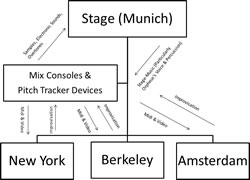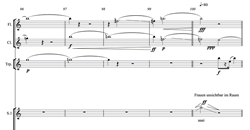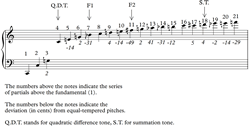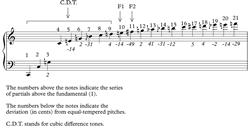Parallel Trajectories in Manfred Stahnke’s Internet Opera “Orpheus Kristall”
In employing microtonality and technology to shape the dramatic narrative of the theatrical music, the German composer Manfred Stahnke has established microtonal structures and technological tools as substantial devices to create musical drama. Implementing Steven Benford’s discussion of the concept of “trajectories”, I explore the ways in which microtonality and technology have become integral means to mediate the philosophical, mythical and psychological connotations of the drama in Orpheus Kristall, Stahnke’s 2001 opera for stage and Internet musicians.
In his article “Performing Musical Interaction,” Benford discusses the ways in which a mixed-reality performance could emerge, through the interaction of live performance and digital media. Elaborating on the hybrid structures generated by combining multiple physical and virtual spaces, multiple time scales, different performative roles and diverse interfaces, Benford argues that the overarching concept of “trajectories” facilitates our perception of such intricate structures. According to Benford, this concept informs the ways by which the performers construct coherent experiences, while each of them might follow their own individual path, meeting at a point to build a social construct of mixed reality (Benford 2010, 57–59).
In the context of Orpheus Kristall, the concept of trajectories illuminates the interrelationship between the various existing plots, the relation of the Internet musicians to the music on the stage, and the multifarious tonal factors. Based on Benford’s classification of three kinds of fundamental trajectories — canonical, participant and historic — I analyze the innovative components of Stahnke’s opera: the function of Internet as a digital media, the diverse microtonal elements and the multivalent plot (Ibid.). We are not only able to observe singular trajectories within each of these three fundamental aspects of the opera — namely the plot, the digital media and the microtonal system — but the various overarching trajectories also together constitute the whole artwork.
In Orpheus Kristall, Stahnke presents an autistic Orpheus bewildered by the complexity of his multimedia environment. Extending the borders of the immediate, live music on stage, Stahnke integrates an external world by means of the Internet, effectively creating the tension between Orpheus’ inner self and external influences. Orpheus uses the Internet as an object to relate to the large, confusing world. The allegorical relation of Orpheus to his extended world symbolizes the reflections of Orpheus’s memories of Eurydice and her catastrophic death. The external world is realized in the performance by the remote musician’s sounds coming to the stage via the Internet, filtered by control boards and amplified by speakers (Bargrizan 2015, 11–13). For example, for the premiere, feeds performed live by individual musicians in New York City, Berkeley (California) and Amsterdam were integrated into the stage performance by the baritone and orchestra in Munich.
The Opera’s Principal Canonical Trajectory and the Role of Internet

Describing the notion of the first of his three fundamental types of trajectories, Benford explains that “artists create canonical trajectories that express one or more ideal journeys through a performance” (Benford 2010, 57). In Stahnke’s opera, the underlying ideas, on which the whole interaction between the stage and the external musicians is based, illustrate its canonical trajectories. With Orpheus Kristall, Stahnke comments on the foundation of our existence in an enormous, complicated exterior. In the present time, using various possibilities of digital media, our existence is strictly tied to the outer world. In this work, Orpheus’ existence is represented not solely by the small stage where the performance takes place, but also by an external world made available via sounds produced by the Internet musicians in real time during the performance. The Internet mediates the projection of the autistic Orpheus’ thoughts attempting to come to terms with his memories. The remote musicians react to his thoughts and improvise (Fig. 1). Their reflections flow back to the stage through the medium of Internet, and Orpheus, now confronted with them, keeps trying to comprehend; this process is the core of the interaction between the two “worlds” that forms the principal canonical trajectory on which the multimedia idea of this opera is based. 1[1. The other canonical trajectory in Orpheus Kristall concerns the central philosophical ideas embedded in opera’s plot, which the integration of a multivalent microtonal fabric implies (see below, “Multiple Tonal Trajectories in ‘Orpheus Kristall’”). These are discussed more extensively by the author in “Technology, Microtones and Mediation in Manfred Stahnke’s ‘Orpheus Kristall’,” Müzik-Bilim Dergisi: The Journal of Music and Science 6/1 (Spring 2015).] The incoming sounds, reflected in the hall, leave Orpheus to deal with his memories, just as they leave us to question our existence through the opera’s content, allegorically representing the fact that our emergence and survival hinges upon an enormous external nature, not solely upon our closed, limited scopes. Furthermore, the opera seeks to break not only the barrier between interior and exterior realms but also the boundary of the immediate stage, by integrating remote stages in various cities around the world, where external musicians react to the stage music and improvise.
Participant Trajectories and the Function of Digital Media
The second of Benford’s trajectories is the participant trajectory, which informs the actual journeys of each participant through the work. These individual experiences are shaped by an interactive environment in which participants make their own choices about how to act and how to drive their trajectories based on the underlying canonical trajectories:
The convergence and divergence of multiple participant trajectories express the social dynamics of a particular performance, reflecting moments at which different participants are brought together to share aspects of an experience, as well as important moments of contemplative isolation in which they are deliberately separated. (Benford 2010, 58)

Stahnke’s opera features the interactive medium of quintet.net, a real-time Internet performance environment designed in Max/MSP that allows remote musicians to participate in a live performance with other musicians playing in another place (Fig. 2). Quintet.net enables the remote musicians to shape their own improvisatory participant trajectories, in contrast to the fixed, notated music on the stage. Individually, each of the remote musicians inscribes another participant trajectory. Multimedia composer George Hajdu from the Hochschule für Musik und Theater Hamburg developed this concept, and Stahnke employed it in his opera. During the performance, the sound engineers transmitted the live stage sounds from Munich through quintet.net to give the information to the remote solo musicians or ensembles in Amsterdam, Berkeley and New York. These remote musicians received the live stage sounds (transformed as MIDI data) in real time while watching the Munich stage image via real-time video streaming. Accordingly, they reacted to the stage music and improvised upon it, and their live performance was immediately streamed back to the hall in Munich.
The Historic Trajectory and Interactivity
The last category of Benford’s trajectories, and the one that grants us a conceptual framework to analyze the interactive aspect of Orpheus Kristall, is the notion of historic trajectories. According to Benford, these involve:
Selecting and recombining segments from among different participant trajectories that have been recorded by the underlying system. In the simplest case, this may involve replaying a given participant trajectory to recreate a particular individual’s experience as it took place. (Benford 2010, 58)

During the 2002 production of Orpheus Kristall in Munich, a crew consisting of the composer and the sound engineers worked on mixing consoles, computers and pitch-tracking devices, receiving the incoming data from the Internet musicians. While filtering the incoming data through their spectrum of partials, they could take one or multiple harmonics and play them back in the hall at the particular spots marked in the score, using samples or electronic sounds. At some points, the incoming Internet-transmitted sounds were intriguingly filtered up to their 33rd overtone, filling the hall with a wide range of natural tones (Fig. 3, measure 13). This very process of selecting, recombining and replaying in real time one or more participant trajectories illustrates the notion of historic trajectories. These historic trajectories, as much as the participant trajectories, are subjugated to the essential canonical trajectories of the opera, the latent and intrinsic narrative inscribed into the whole process.
Multiple Tonal Trajectories in “Orpheus Kristall”
If we broaden the reach of the concept of trajectories from the interactive digital media involved in Orpheus Kristall to the tonal structure of the opera, we observe three individual tonal trajectories. Analogues to the various participant trajectories in the technological construction of the opera, Orpheus Kristall is comprised of three microtonal elements, which hand in hand address a central narrative. This central narrative informs the extra-musical connotations of the opera, which I consider as the underlying canonical trajectories embedded in the plot.
In this opera, Kristall is a metaphor for nature, for Orpheus’ corrupted world. Stahnke borrowed this term from the Austrian physicist, Erwin Schrödinger’s concept of “aperiodic crystal” in his influential book What Is Life? (1944). In this seminal text, conceived in an era before the biological structure of the human DNA was fully exposed, Schrödinger proposes the concept of “aperiodic crystal” as the molecular material carrier of life. He juxtaposes this concept, which stands for the rather complicated and non-repetitive structure of a gene, against the rigid and plain structure of the natural “periodic crystals” as it was already understood in the physics (Schrödinger 1944, 60–61).
Stahnke, inspired by Schrödinger’s thesis, used the complicated, rigorous structure of periodic crystals as a metaphor of his intricate, microtonal system, comprising 53 tones to the octave. In this regard, Stahnke wonders:
How are we able to plan out something like an Internet opera that involves both the formation of crystals (tone systems) and the running of the Internet? Tone systems are analogous to crystals, but in omnivorous Europe, the crystals (our great-grandfather, 12-tone equal temperament) are already quite aged. (Stahnke 2002, 27) 2[2. “Wie ist so ein Ding „Internetoper“ zwischen Kristallbauen und Internet-Laufenlassen zu planen? „Tonsysteme” gehören zu Kristallen, aber in diesem allesfressenden Europa sind die Kristalle gealtert (unser Urgroßvater „12ton-Temperierung”).”]
Stahnke employs his tone system, including the partials up to the 21st overtone, in the harmonic series. His system consists of 53 equal intervals, which linearly would build a scale that is extremely close to an eighth-tone scale. 3[3. The less than three-cent difference between the 53-tone equal-tempered scale (1200/53 = 22.6 cents) and eighth tones (1200/48 = 25 cents) is so small that the steps can be approximated to eighth tones.] About the relationship of this scale to the ancient musical cultures and its characteristics, Stahnke mentions:
Even the ancient Chinese theoreticians knew that building up a scale of 53 consecutive natural fifths practically results in the octave. 53 tempered steps per octave linearly contains ca. 8th tones, while vertically it gives the intervals, for example, up to the 21st harmonic. Using 53 tones to octave opens a door to a lexicon of perverse and useful sounds, which brings us suspiciously close to the world of “noises”. (Stahnke, 2002, 23) 4[4. “Sogar die alten Chinesen wussten, dass nach 53 reinen Quinten übereinander praktisch die Oktave erreicht ist. 53 temperierte Schritte pro Oktave ergeben linear zirka Achteltönen, vertikal z.B. praktisch naturreine Intervalle bis zum 21. Naturton. Mit 53 Tönen öffnet sich ein Lexikon des Perversen und Nützlichen, wir sind dem Rauschen verdächtig nah.”]
Here, we see how Stahnke’s tonal concept has its roots in the Ancient World as well as in the natural world, representing the world of Orpheus and the world of the natural, untempered tones — questioning our dominating, equal-tempered tonal world.
The second significant microtonal element in the opera is the slow, long, microtonal glissandi, where we can experience a diverse and constantly morphing microtonal world (Fig. 4). In Orpheus Kristall, the extensive use of microtonal glissandi is related to the constantly mutating thoughts of the autistic Orpheus. Stahnke relates the extensive use of these glissandi to the storyline, as follows:
There is the threshold of form recognition in the constantly mutating meloharmonic image as a consequence of microtonal glissandi and pulse fluctuations, as if Hades were the world of “formlessness,” and “form” came from a different — and inaccessible — world. (Stahnke 2002, 24) 5[5. “Es gibt die Schwelle des Gestalterkennens in einem stets mutierenden meloharmonischen Bild infolge von Mikroglissandi, Pulsschwankungen — als wäre der „Hades“ der Ort der Gestaltlosigkeit und als käme Gestalthaftes aus einer anderen — unerreichbaren — Welt.”]

In other words, the vague microtones, as opposed to the familiar tones of the equal-tempered 12-tone scale, inform “formlessness vs. form”. Orpheus desperately desires to reach his now-dead, formless Eurydice. Hence, he travels to Hades, where the distinction between form and formlessness is not as clear. He nearly regains his Eurydice, but he loses her again and therefore loses himself as well. This dichotomy between the notions of form and formlessness is conceived throughout the work by means of a contrast between the realm of half and whole tones and the domain of microtones, all of which is amplified by the improvisatory world of Internet-transmitted sounds, in contrast to the stage-produced sounds. To realize the dichotomy of form and formlessness in the music, Stahnke expands the world of fixed half and whole tones to a world of endless tones, where the tone is an unfixed phenomenon. By allegorical adoption of a multilayered microtonal structure, Stahnke breaks the barrier of the equal temperament that had characterized our somewhat limited world of the tempered fixed tones (Bargrizan 2016, 16).
As an allegory to Schrödinger’s concept of “aperiodic crystals”, Stahnke’s concept of “difference-tone harmony” — the underpinning of opera’s harmonic structure — is equally significant. In the composer’s words:
If this enormous apparatus, the Internet, with its uncontrollable character has to be integrated on the stage, as a counterbalance, a precisely-built “crystal” should also be present on the stage. My difference-tone harmony could become a comprehensive meloharmonic concept for the entire opera. (Stahnke 2001, 27) 6[6. “Wenn schon dieser riesige Apparat des Internet mit seinem unsteuerbaren Spielcharakter in die Oper einbrechen soll, müsste als starkes Gegengewicht ein sehr präzise gebautes „Kristall” auf die reale Opernbühne gestellt werden. Meine Differenztonharmonik könnte zu einem umfassenden meloharmonischen Konzept für die Oper werden.”]
The psychoacoustic concept of difference-tone harmony that Stahnke refers to is what happens naturally in our ears when we hear any interval. As soon as we hear an interval, its sum tone emerges as an overtone, and its quadratic as well as its cubic difference tones emerge as undertones (Figs. 5–6). We, however, are only able to perceive these naturally occurring psychoacoustic phenomena in specific acoustic conditions — normally involving substantial amplification, correct intonation and a lack of vibrato. Extending the scope of his microtonal system, throughout Orpheus Kristall, Stahnke uses difference tones to build just-intoned chords, constructing the harmonic structure of the opera. In fact, each of these individual microtonal elements creates separate, continuous tonal journeys, which as unifying threads add multiple layers to this multifaceted interactive work. The amalgamation of the stage and Internet sounds functioning on different levels facilitates the canonical trajectories of the plot, which then inform the opera’s multivalent storylines, all of which work to address the philosophical underpinnings of the opera.


Regarding the dramatic narrative in Orpheus Kristall, Stahnke states: “This opera does not tell a story. The story is rather pushed so far into the background that only an echo of the story remains to be heard” (Bargrizan 2012, 196). 7[7. “Trotzdem ist diese „Oper“ kein Ding, das eine Geschichte erzählt. Die Geschichte ist eher so tief eingesickert, dass nur ihr Echo zu hören bleibt.”] Stahnke considers, however, at least two distinct, possible storylines. First, the classic story of Orpheus, who descends to the underworld of Hades to retrieve his beloved Eurydice; he fails and eventually collapses. Second, a transformation of the Orpheus myth: he escapes from the underworld, but Eurydice seduces him when she realizes that she would no longer be able to have contact with Orpheus (Bargrizan 2012, 106–110).
In Stahnke’s opera, Orpheus rules a world that extends beyond the borders of the stage. The composer adds some other islands across the world to Orpheus’s territory of the opera hall. These islands are connected to the main stage through the Internet — from New York and Berkeley to Amsterdam. Within this new world, the autistic Orpheus suffers from his memories of falling in love with Eurydice, winning her and eventually losing her. “He even may have murdered her,” suggests Stahnke — this possibility leads to another component of the opera: Stahnke points out the desire “to make or to build, but to do so in vain, because since we cannot ‘win’ the world, we destroy that which we have built” (Bargrizan 2012, 108). 8[8. “Er hat sie vielleicht auch gemordet, das ist eine mögliche Komponente in unserer Oper. Das hat uns die Texterin nahegebracht: Das Bauen, aber das Umsonstbauen, weil ich die Welt nicht gewinnen kann, deshalb zerstöre ich sie.”] As a matter of fact, all these possible plots coexist simultaneously, throughout the opera. This coexistence, the inherent complexity and the intentional ambiguity of the plot, alongside the intricate tone system and the interactive function of the Internet, in turn produce a sort of a hyper-reality beyond the boundaries of the traditional dramatic and musical narratives, and beyond the implications of the ancient Orpheus myth.
Conclusion
Even though Benford attempts to clarify the ways in which the concept of trajectories might potentially apply to the design of interactive devices in the musical performances, I have utilized this concept to analyze not only the virtual function of digital media in Orpheus Kristall, but also the physical properties of its tonal construction and its multidimensional dramatic narrative. Within all three essential aspects of the opera, namely the stage and Internet musicians, tone systems and the multivalent storyline, we observe distinct participant trajectories. These trajectories cooperate to delineate the canonical trajectories, the philosophical implications of the whole artwork, which point to the fact that our emergence and existence is rooted in an enormous nature, the source of our DNA and our biological evolution. Both the predominance of the just-tuned natural tones, the theme of nature embedded in the plot and the external sounds coming to the stage from far away imply this existential issue. Moreover, the use of digital media hints at another existential issue, namely how nowadays our lives hinge upon the virtual world of Internet and digital media. Lastly, Stahnke’s search toward new sound structures that break through the limited scope of the prevailing equal temperament demonstrates a personal tendency of the composer to not confine himself within established idioms and his constant longing for new new conceptual, tonal and theatrical paradigms.
Stahnke’s integration of digital media and electronic enhances the function of his meloharmonic constructions in the dramatic narrative of his works. According to his multi-dimensional approach to the art, he creates new opera concepts that rest upon incorporating and synthesizing a range of elements, including exotic meloharmonic ideas, improvisation, electronic sounds and digital media, all the while basing this construction on elaborated versions of literary sources that contain philosophical, psychological and existential connotations. Stahnke appoints an essential role for the microtonal structures as well as for the technological devices he uses in the context of his hybrid operas.
Bibliography
Bargrizan, Navid. “Aspekte mikrotonaler Komposition.” Unpublished master’s thesis, Universität Hamburg, 2012.
_____. “Technology, Microtones and Mediation in Manfred Stahnke’s ‘Orpheus Kristall’.” Müzik-Bilim Dergisi: The Journal of Music and Science 6/1 (Spring 2015), pp. 11–28.
Benford, Steven. “Performing Musical Interaction: Lessons from the study of extended theatrical performance.” Computer Music Journal 34/4 (Winter 2010) “Human-Computer Interaction 1,” pp. 57–59.
Schrödinger, Erwin. What Is Life? Cambridge MA: Cambridge University Press, 1944.
Stahnke, Manfred. “Ein Tonsystem für eine Internetoper. ” Edited by Gisela Nauck. Positionen: Beiträge zur neuen Musik 48 (August 2001) pp. 27–30.
_____. “Orpheus unter den ganzen Zahlen: ein Essay über Schwellen,” in Melodie und Harmonie: Festschrift für Christoph Hohlfeld zum 80. Geburtstag. Edited by Reinhard Bahr. Berlin: Weidler Buchverlag, 2002, pp.183–196.
Social top